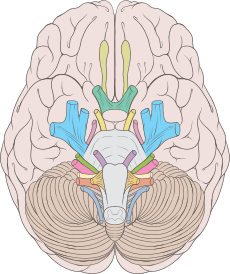- Cranial nerve disease
-
Cranial nerve disease Classification and external resources 
Cranial nervesICD-10 G50-G53 ICD-9 350-352 DiseasesDB 17207 MeSH D003389 Cranial nerve disease is a term used to describe an impaired functioning of one of the twelve cranial nerves.
Although it could theoretically be considered a mononeuropathy, it is not considered as such under MeSH.
It is possible for a disorder of more than cranial nerve to occur at the same time, if a trauma occurs at a location where many cranial nerves run together, such as the jugular fossa. A brainstem lesion could also cause impaired functioning of multiple cranial nerves, but this condition would likely also be accompanied by distal motor impairment.
A neurological examination can test the functioning of individual cranial nerves, and detect specific impairments.
Examples
- Eyes
- Oculomotor nerve palsy - Oculomotor nerve (III)
- Fourth nerve palsy - Trochlear nerve (IV)
- Sixth nerve palsy - Abducens nerve (VI)
- Other
- Trigeminal neuralgia - Trigeminal nerve (V)
- Facial nerve paralysis, Bell's palsy, Melkersson-Rosenthal syndrome, Central seven - Facial nerve (VII)
- Accessory nerve disorder - Accessory nerve (XI)
Nervous system pathology, PNS, somatic (G50–G64, 350–357) Nerve, nerve root, plexus Cranial nerve
diseaseV (Trigeminal neuralgia, Anesthesia dolorosa) · VII (Facial nerve paralysis, Bell's palsy, Melkersson–Rosenthal syndrome, Parry–Romberg syndrome, Central seven) · XI (Accessory nerve disorder)Lower limbGeneralPolyneuropathies/Polyradiculoneuropathy OtherCategories:- Disease stubs
- Neuroscience stubs
- Nerve, nerve root and plexus disorders
- Eyes
Wikimedia Foundation. 2010.
